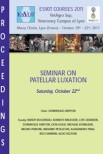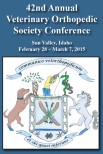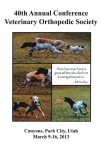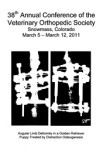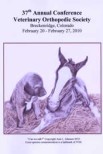Dog Mix breed 1 and half year old. Male intact. Presented with bilateral hind limb lameness. On the clincal examination, the lameness was localised on both the stifles with thickening of both proximal Tibiae, hard on palpation and more marked signs on the right side. Radiographs of both the stifles were taken. Radiographic examination Mediolateral view (on the left), craniocaudal (in the middle) of the right stifle and mediolateral view (on the right) of the left stifle. Radiographic findings
- There is moderate proximodorsal dislocation of a bone fragment of homogenous radioopacity, compatible with tuberositas tibiae (arrow).
- Surrounding this fragment, there is extensive new bone proliferation, well defined but irregular and proximally cloudy, of mild heterogenous radioopacity (empty arrows).
- Mild patella alta (arrowhead).
- The findings are bilateral and symmetrical.
Radiographic findings Close up of the ML view of the right stifle Radiographic diagnosis
- The radiographic diagnosis was bilateral tibial tuberosity chronic avulsion, compatible with the human diseases known as Osgood-Schlatter.
- The dog was operated on the right side and during the surgery, a biopsy sample was taken for histological analysis.
- The result of the biopsy was: Chondroid hyperostosis of the tuberositas tibiae with focal hyperplasia of the periostium and minimal chronic lymphoplasmacellular periostitis.
- e findings were compatible with the described Osgood-Schlatter disease of human medicine.
Radiographic examination Lateromedial (on the left) and craniocaudal (on the right) post OP radiographs of the right stifle Comments
- Several different theories have been proposed as possible pathogenesis in humans.
- In dogs, a genetical predisposition has been suggested in Grayhounds with possible osteochondrosis at the apophyseal plate and subsequent displacement or avulsion ot the tibial tuberosity.
- Another report shows that trauma is the precipitating cause for avulsion, which seems to occur especially in dogs with deep angles of inclination of the tibial pleteau (35-55°).
- A new classification has been proposed (von Pfeil et al, Vet Comp Orthop Traumatol 2009):
- Type I avulsion: Minimal or no displacement of the tibial tuberosity with increased width of the apophyseal plate, typically in young dogs prior to complete closure of the apophyseal physis (up to 18 months of age in giant breeds).
- Type II avulsion: Fracture line occasionally reaching into the epiphysis with mild displacement of the tibial tuberosity. Mild proximal displacement of the patella (patella alta) may be observed. Typically in 8 to 11 months old dogs.
- Type III avulsion: Avulsion of the apophysis with a fracture extending through the epiphysis into the stifle joint, causing intra-articular step. Often marked displacement of the tibial tuberosity and patella alta. Typically in dogs from 3 to 8 months of age.
From: von Pfeil et al., Vet Comp Orthop Traumatol 2009
